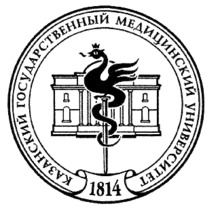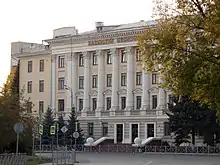Kazan State Medical University
 | |
| Motto | Omnium profecto artium medicina nobilissima (Latin) |
|---|---|
| Type | Public |
| Established | 1814 |
| Chancellor | Aleksey Sozinov |
Administrative staff | 1,400 (700 academic staff) |
| Students | 4,000 |
| Location | Kazan , Russia 55°47′26.26″N 49°8′27.23″E / 55.7906278°N 49.1408972°E |
| Campus | urban |
| Nickname | KSMU |
| Website | kazangmu |
The Kazan State Medical University (KSMU) is a medical university located primarily in Kazan, Tatarstan, Russia. It is composed of nine faculties.
The university obtained its license on March 6, 1994, from the State Committee of the Russian Federation of Higher Education. Kazan State Medical University is a state institution of higher learning in medicine that operates under self-governance and is part of the Higher Education and Scientific Research system of the Ministry of Health of Russia. The university was granted license number 16 G-235 on March 6, 1994, by the state.
In addition to Kazan State Medical University, there are also a pharmaceutical college and two medical colleges in Kazan, along with a medical college named Mary E. I. Republic, a lycee, and biomedical classes based on secondary schools. KSMU is ranked 16th out of 86 other universities in a rating of medical schools. It was founded in 1814, making it the second university established in Kazan and the third medical university in Russia.
Rankings and reputation
According to the Academic Ranking of World Universities—European Standard ARES-2014, published by the European Scientific-Industrial Chamber, Kazan State Medical University (KSMU) was ranked third among medical universities in Russia. KSMU holds the position of 4489 in the Webometrics Ranking of World Universities[1] and is ranked 6381 in the 4ICU world university ranking.[2]
Geography and location

Kazan State Medical University (KSMU) is situated in the central area of Kazan.
Teaching system
The curriculum for general medicine (equivalent to M.B.B.S.), dentistry, and pharmacy at Kazan State Medical University (KSMU) is comprehensive and regularly updated. Each subject encompasses the study of diseases with a focus on epidemiology, etiology, pathogenesis, pathological physiology, pathological morphology, clinical presentation, laboratory and instrumental examination methods, diagnosis, differential diagnosis, complications, prognosis, treatment, and prevention. The use of Latin terms follows the international nomenclature of various specialties. Throughout their training, students progress through theoretical subjects (from the 1st to the 3rd year) and clinical fundamentals (from the 4th to the 6th year), acquiring essential practical skills.
History
In 1804, Emperor Alexander I issued a royal command to establish a university in Kazan.
In 1814, the Faculty of Medicine was inaugurated at Kazan Emperor University.
In 1837, the Anatomical Theater, a distinctive example of Russian classicism from the 19th century, was constructed based on the design of Italian anatomical theaters from the Renaissance period. The project was led by M.P. Korinfskiyi with the participation of Nikolai Lobachevsky, the rector of Kazan Emperor's University.
In 1840, the university clinic was established.
In 1930, the Medical Faculty of Kazan State University underwent reorganization and became the Kazan Medical Institute.
On April 29, 1994, Kazan Medical Institute attained the status of Kazan State Medical University.